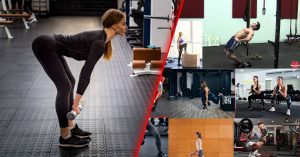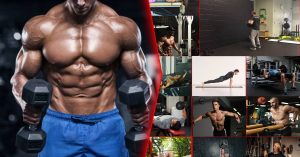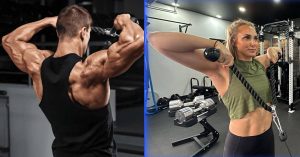A strong back is more than just a symbol of strength; it’s the foundation of our body’s movement and balance. Think about it—whether you’re picking up a book, playing sports, or even just standing straight, your back is quietly at work. Gym back workout machines are not just equipment; they’re your partners in carving out a healthier, more powerful version of yourself.
Navigating the gym can be daunting, especially with the array of machines each promising the path to strength. Yet, not all machines are created equal, especially when it comes to building back strength. Gym back workout machines stand out—they’re designed with precision to target the back muscles effectively.
But with so many options, how do you know which ones to focus on? More importantly, how do these machines fit into the broader picture of your fitness journey? Let’s dive deeper and uncover the secrets behind choosing the right machines for your back workout in this guide.
Table of contents
MORE keyboard_double_arrow_down LESS keyboard_double_arrow_up
The Role of Gym Back Workout Machines in Your Fitness Regime
Gym back workout machines do more than just strengthen your back; they play a crucial role in your overall fitness regime.These machines help improve your body’s ability to perform everyday activities with ease.
By strengthening the back muscles, they protect your spine, ensuring you’re less prone to injuries. Furthermore, a strong back means better posture, which is key to looking and feeling confident.
Choosing the Right Machines
With a plethora of machines available, selecting the right ones can feel like finding a needle in a haystack. Yet, the secret lies in understanding what each machine offers:
- Targeted Muscle Engagement: Look for machines that target specific back muscles for focused training.
- Adjustability: Machines that offer customization can adapt to your unique body, enhancing safety and effectiveness.
- Versatility: Opt for machines that offer a range of exercises to keep your workouts fresh and challenging.
The Best Gym Machines for Back Workouts with Exercises
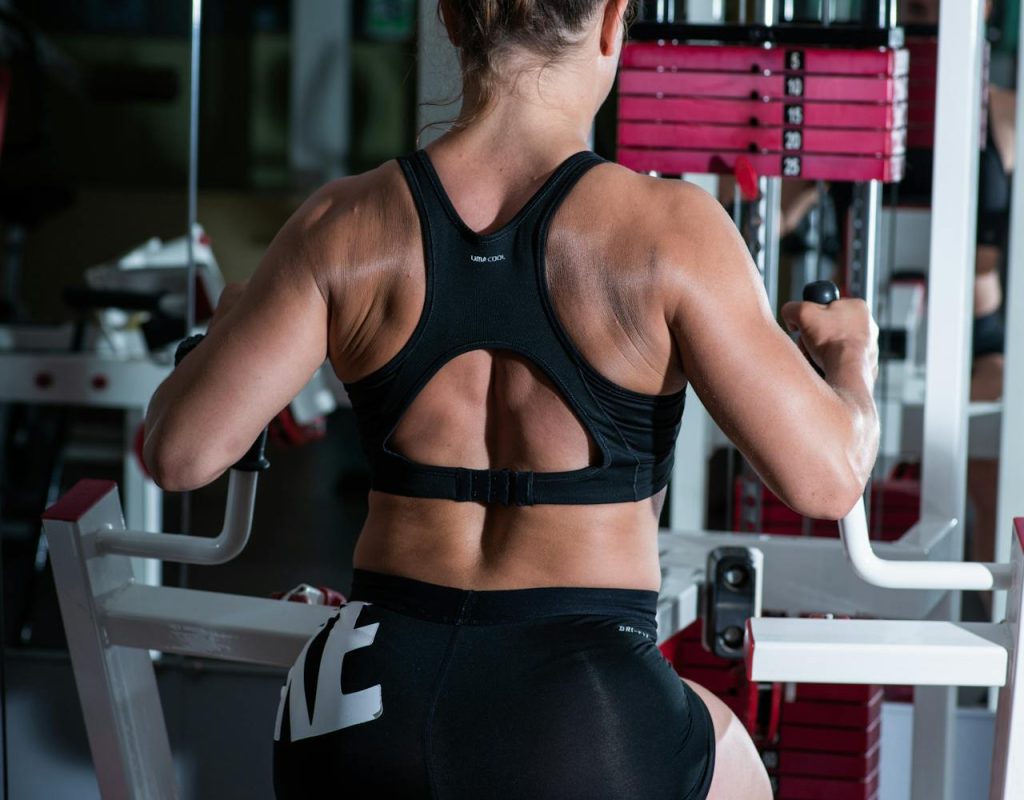
Embarking on the journey to sculpt a powerful back demands the right tools. In the vast sea of gym equipment, certain machines including upper body workout machines stand out as beacons for back development. Here they are:
Lat Pulldown Machine
The lat pulldown machine is a popular back fitness machine that helps you build a stronger back. It works by pulling a bar down towards your chest, mainly targeting your back muscles, especially the “lats.”
You can do different types of lat pulldowns by changing how you hold the bar. This lets you work different parts of your back. The machine often has different handles you can use for various grips.
Here are some types of lat pulldowns:
- Wide grip: Works your whole back
- Close grip: Targets the inner part of your back
- Reverse grip: Works your biceps more than your back
The lat pulldown also works other muscles in your back and arms, but the lats are the main ones it targets.
Here’s how to do a lat pulldown:
- Sit on the machine and adjust the leg pads.
- Choose a weight that feels challenging but not too heavy.
- Hold the bar with a wide grip and your arms straight up.
- Pull the bar down towards your chest, using your back muscles, not your arms.
- Slowly raise the bar back up to the starting position.
Expert tip: “When using the lat pulldown machine, make sure to keep your shoulders down and back, and avoid leaning backwards,” says Michele Olson, Ph.D., an exercise scientist and professor of sports science at Huntingdon College in Montgomery, Alabama.
Seated Row Machine
The seated cable row is an exercise that uses a machine to strengthen your back and arms. It’s a good exercise for beginners and can be done in different ways to target different muscles in your back.
Here’s how to do it:
- Sit on the machine with your knees bent and feet on the support.
- Grab the handles with your arms straight and back straight.
- Pull the handles towards your lower chest, keeping your back straight and chest up.
- Slowly release the handles back to the starting position.
This exercise works your middle back muscles, latissimus dorsi, rear delts, and biceps.
Expert tip: “When using the seated cable row machine, focus on squeezing your shoulder blades together as you pull the handles towards you,” says Jessica Matthews, an exercise physiologist and assistant professor of kinesiology at Miramar College in San Diego.
Chest Supported Row
The chest-supported row machine is a gym tool that helps you build back muscles without straining your lower back. It has a padded chest rest to support you and handles you can grab in different ways.
This machine is good for people with lower back problems or those who want to focus on their upper back muscles. It mainly works your lats, traps, rhomboids, and rear delts, with your biceps and forearms helping out.
Here’s how to use it:
- Sit on the machine and adjust the seat so your chest rests comfortably against the pad.
- Grab the handles with your back straight and core engaged.
- Pull the handles towards your body, keeping your chest pressed against the pad.
- Slowly release the handles back to the starting position.
Landmine Row
Want to spice up your back workout at the gym? Try the landmine row! It’s a different way to do rows, using a barbell anchored in a special holder or corner.
This unique exercise works your back muscles in a fresh way, hitting your lats, traps, rhomboids, and spine muscles. It also works other muscles like your shoulders, biceps, forearms, core, and even your glutes and abs!
Here’s how to do it:
- Secure one end of a barbell in a landmine attachment or corner.
- Stand facing the weighted end, feet shoulder-width apart.
- Bend slightly at your knees and hips, like a half-squat.
- Grab the end of the barbell and pull it towards your chest.
- Slowly lower the barbell back down.
Pec Deck Machine (Reverse Fly)
The pec deck machine isn’t just for chest exercises! You can flip it around and use it for “reverse flies” to target your upper back muscles. This is a simple but effective exercise that can help you build stronger and more defined shoulders.
Here’s how to do it:
- Adjust the seat and handles of the machine so you’re comfortable.
- Sit down with your back pressed against the pad and your feet flat on the floor.
- Grab the handles and pull your arms out and back in a smooth arc, like you’re making a big hug.
- Slowly bring your arms back to the starting position.
This exercise mainly works your rear deltoids (the back of your shoulders), but also helps strengthen your traps, rhomboids, and other smaller muscles in your upper back.
Back Extension Machine
Want to strengthen your lower back and improve your posture? The back extension machine is a great tool for both beginners and experienced gym-goers.
This machine helps you safely perform back hyperextensions, which target your erector spinae muscles, the main group in your lower back. It also works your glutes, hamstrings, and core muscles.
Here’s how to use it:
- Lie face down on the machine and adjust the pad to fit your legs.
- Bend your knees slightly and secure your feet under the footplates.
- Relax your arms across your chest or by your head.
- Breathe out as you raise your upper body until your back is straight. Squeeze your core muscles and keep your shoulders back.
- Breathe in and slowly lower yourself back down in a controlled movement.
For more tips on how to use the back extension machine, take a look at this Instagram post by Alice Jane, a woman’s transformation coach:
Smith Machine for Back Workout
The Smith machine is a versatile gym machine with a barbell that slides up and down metal rails. This makes it safer and easier to control than free weights, which is great for both beginners and experienced lifters.
You can do many different back exercises on the Smith machine, including bent-over rows, rack pulls, and upright rows. These exercises target different back muscles, but some of the most common ones they work include your lats, traps, and rhomboids.
Here’s how to do a Smith machine bent-over row, which mainly works your lats:
- Adjust the bar on the Smith machine to about knee height.
- Stand facing the bar with your feet shoulder-width apart and bend your knees slightly.
- Hinge at your hips to lean forward, grab the bar with an overhand grip, and lift it slightly to remove it from the safety stoppers.
- Pull the bar towards your lower chest, keeping your back straight.
- Slowly lower the bar back down to the starting position.
Assisted Pull-Up Machine
Pull-ups are a great exercise for building upper body strength, but they can be tough! If you’re new to fitness, recovering from an injury, or just need a little help, the assisted pull-up machine is your friend.
This machine uses weights to help you lift some of your body weight, making pull-ups and chin-ups easier. It has a pull-up bar, a weight stack, and a platform for your knees or feet.
Here’s how to use it:
- Choose a weight that helps you, but still challenges you.
- Put your knees or feet on the platform.
- Grab the bar with your preferred grip (palms facing you for chin-ups, palms facing away for pull-ups).
- Pull yourself up until your chin clears the bar.
- Slowly lower yourself back down.
This exercise works your back muscles (lats, rhomboids, traps), biceps, forearms, and core.
Rowing Machine
The rowing machine, or “rower,” is a gym machine that mimics rowing a boat. It’s great for both cardio and strength training, working multiple muscle groups at once.
It has a sliding seat, footrests, a handle, and a flywheel for resistance.
Here’s what it works:
- Legs: Quads, hamstrings, and calves when you push off with your feet.
- Back: Lats, rhomboids, and upper traps when you pull the handle.
- Core: Abs, obliques, and lower back for stability.
- Arms: Biceps and triceps during pulling and recovery phases.
- Shoulders: Rear deltoids when pulling, front deltoids during recovery.
Here’s how to use it:
- Sit on the seat and secure your feet.
- Grab the handle, extend your legs, and slide forward by bending knees.
- Push through your heels and pull the handle towards your lower ribs.
- Reverse the motion by extending your arms and sliding back with your knees bent.
Double Pulley Cable Machine
The double pulley cable machine is a gym machine with two adjustable handles. It’s great because it lets you do many different pulling and lifting exercises that target different parts of your back muscles.
Unlike free weights, this machine keeps the muscles working throughout the entire movement, which can help you build strength, size, or endurance in your back muscles. Here are some exercises you can do on this machine:
- Face pulls: These work the muscles in the back of your shoulders and upper back, which can help improve your posture and shoulder health.
- Straight-arm pulldown: This exercise focuses on the large muscles in your lower back without using your arms, making it a good finisher for your back workout.
- Single-arm cable row: This exercise lets you move your arm further and works one side of your back at a time.
- Cable pull-through: This exercise mainly works your lower back and buttocks, but also uses your lower back muscles to pull.
- Cable high row: This exercise targets the upper part of your back muscles, which can help shape your upper back.
- Cable Y-raise: This exercise focuses on the lower part of your upper back muscles, which can improve your posture and shoulder stability.
- Cable shrugs: This exercise works the upper part of your shoulder muscles, which can help make your shoulders look bigger.
- Cable upright row: This exercise is similar to using a T-bar machine, and it works the middle and upper part of your back muscles.
- Standing low cable row: This exercise works the lower part of your back muscles and core muscles, which help keep you stable.
Benefits of Using Machines for Training Back Muscles
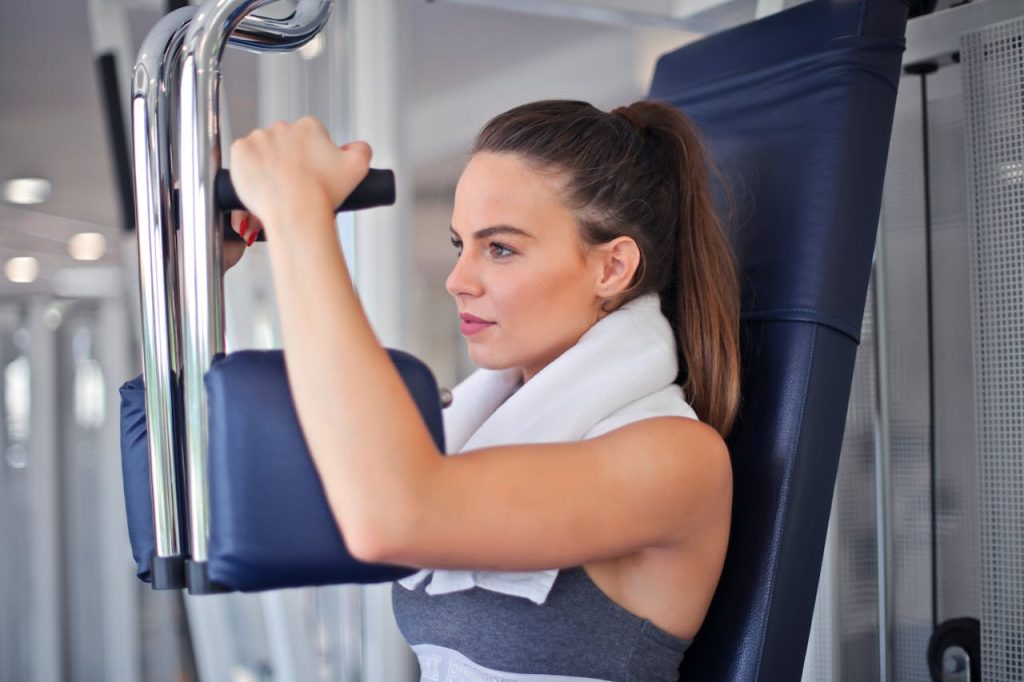
Targeted Muscle Engagement
The debate between free weights and machines is like a friendly competition that will likely never have a clear winner, because both offer unique advantages. While free weights tend to engage a wider range of muscles in a single exercise, making them great for building overall strength and coordination, machines excel at isolating specific muscle groups.
Think of it like a full team effort versus focusing on a star player. Machines are perfect for pinpointing and improving weaker muscles, almost like giving them a solo training session. Ultimately, the “best” choice depends on your individual goals.
If you’re aiming for general strength and coordination, free weights are a good bet. But if you want to target and improve specific muscles, machines can be your secret weapon.
Safety and Control
Gym machines are often considered safer than free weights, especially for beginners. This is because machines offer several advantages that can help prevent injuries:
- Adjustable settings: Most machines have adjustable seats, pads, and weight stacks. This allows you to customize the fit comfortably and safely, reducing the risk of awkward positions or improper form that can lead to injuries.
- Controlled movement: Machines guide your movement along a specific path. This controlled motion helps prevent you from accidentally putting yourself in a position that could cause strain or injury, especially when lifting heavier weights.
- Reduced dependence on spotters: Compared to free weights, machines often require less reliance on a spotter for safety. This can be helpful for beginners who are still learning proper form and may not have someone available to assist them.
Versatility
The versatility of these machines is like a breath of fresh air in your workout routine, ensuring you never hit a plateau. With options to adjust weights, positions, and movements, each session on a gym back workout machine can offer a new challenge.
This diversity not only keeps your workouts engaging but also stimulates muscle adaptation and growth, ensuring your back continues to strengthen and evolve.
Structured Path to Strength
For beginners and those on the road to recovery, the structured nature of gym back workout machines offers a beacon of hope. These machines provide a guided path to strength, allowing for gradual increases in intensity without undue strain on the body.
High-Volume Training
For those chasing high-volume training, the efficiency and effectiveness of gym back workout machines are unmatched. They allow you to maintain intensity and form over longer sessions, ensuring your back gets the rigorous workout it needs.
It’s the equivalent of having an endurance coach by your side, pushing you to maintain peak performance throughout your session.
Conclusion
Gym back workout machines stand as pillars in the temple of back strength training. They blend targeted muscle engagement, safety, and versatility into a seamless workout experience. Whether you’re a fitness newbie or a seasoned athlete, these machines offer a tailored path to a stronger, more defined back.
By embracing the lat pulldown, seated row, and the dynamic double pulley cable machine, you’re not just working out; you’re embarking on a transformative journey towards peak physical fitness. Let these machines be your guide, and marvel at the strength and posture you develop on the way.
Key Points
- Gym back workout machines are essential tools for developing back strength, offering precise muscle targeting.
- These machines enhance workout safety by providing controlled movements, reducing the risk of injury.
- Versatility is a major benefit, with machines offering various adjustments and settings to keep workouts engaging and challenging.
- They provide a structured approach to strength training, ideal for beginners and those in rehabilitation.
- High-volume training is supported by the efficiency and effectiveness of these machines, allowing for sustained intensity and form.
- Key machines for back workouts include the lat pulldown, seated row, chest supported row, landmine row, pec deck machine (reverse fly), back extension machine, Smith machine, assisted pull-up machine, rowing machine, and double pulley cable machine.
- Using gym back workout machines leads to targeted muscle engagement, ensuring each exercise maximizes muscle growth and definition.
- The safety features and adjustable settings of these machines allow users to exercise with minimal risk and optimal form.
- The adaptability of gym machines ensures a dynamic workout experience, preventing boredom and promoting continuous muscle development.
- Machines offer a guided fitness journey, making them suitable for users at different fitness levels and with varying goals.
- Embracing a variety of back workout machines can lead to comprehensive back development, improving strength, posture, and overall fitness.
FAQs
What machines are best for back workouts?
The lat pulldown, seated row, chest supported row, landmine row, pec deck machine (reverse fly), back extension machine, Smith machine, back pull machine, assisted pull-up machine, rowing machine, and double pulley cable machine stand out as champions of back training.
Why should I use machines for back workouts?
They offer a unique blend of targeted muscle engagement, safety, workout variety, ease of use, and the ability to support both rehabilitation and high-volume training effectively.
Incorporate these machines into your routine and watch as your back transforms, becoming a symbol of strength, resilience, and unmatched power.

ABOUT THE AUTHOR
Follow Valen Steven for a dose of fitness enthusiasm, evidence-based advice, and a roadmap to achieving your health and wellness goals.
Subscribe to our Newsletter
Dive into a world of fitness and wellness with our exclusive newsletter! Sign up now and receive weekly power-packs of fitness wisdom


